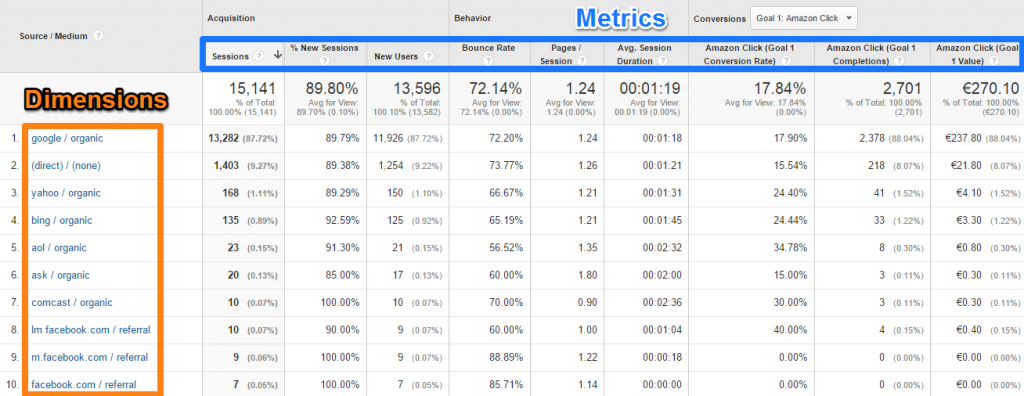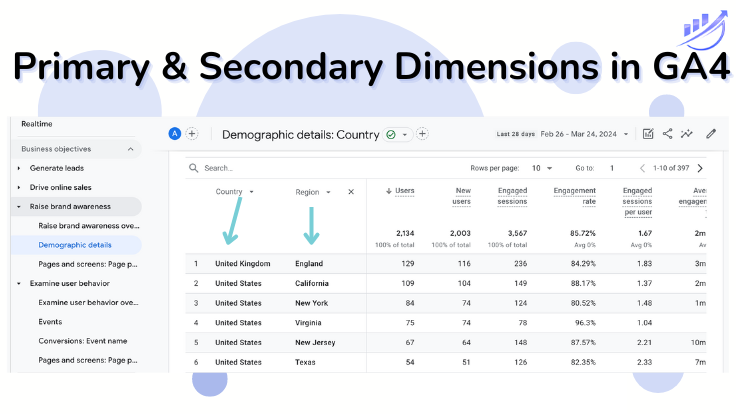Insights into the 'Secondary Dimension' in Google Analytics: A Thorough Description
Insights into the 'Secondary Dimension' in Google Analytics: A Thorough Description
Blog Article
Demystifying Secondary Dimension in Google Analytics: The Key to Recognizing Your Information Like Never Prior To
In the world of electronic analytics, the ability to remove meaningful understandings from data is paramount for educated decision-making. Amidst the huge selection of tools readily available, Google Analytics stands apart as a powerhouse, yet many users continue to be uninformed of the untapped prospective existing within its Additional Dimension function. By peeling off back the layers of complexity surrounding this tool, a whole brand-new world of data interpretation and evaluation reveals itself. Understanding the subtleties of Second Measurement could be the missing out on piece in your analytics puzzle, clarifying trends and connections that were formerly obscured.
Comprehending the Essentials of Second Dimension
Second measurements in Google Analytics offer as additional characteristics that supply much deeper insights into primary information metrics, enhancing the total understanding of user habits and interactions on a website. By including additional measurements to your main data metrics, you can segment and assess your information further, revealing useful information that might have been concealed or else.
Recognizing the basics of second measurements is critical for maximizing your website's efficiency and individual experience. what is a “secondary dimension” in google analytics?. When utilizing secondary measurements, it is necessary to understand that they can be added to various records in Google Analytics, allowing you to explore additional aspects of your data past the conventional dimensions
Moreover, second measurements enable you to contrast and contrast different data factors, assisting you determine patterns, patterns, and relationships that can educate your advertising techniques and website optimizations. Whether assessing traffic resources, individual demographics, or habits on specific web pages, secondary dimensions play a pivotal function in extracting meaningful understandings from your Google Analytics data.
Using Additional Dimension in Records
To grow the analysis of customer actions and communications on a website, integrating secondary dimensions right into reports in Google Analytics gives a much more comprehensive understanding of information metrics. By using secondary dimensions in reports, analysts can uncover important insights that surpass the surface-level data given by primary measurements alone. This feature allows customers to section and pierce down into their information better, revealing relationships and patterns that might have or else gone unnoticed.
With the application of additional dimensions, customers can gain a much deeper understanding of the context surrounding their key data points. As an example, incorporating the main dimension of 'source/medium' with an additional dimension like 'landing page' can reveal which details landing pages are driving website traffic from various resources. This degree of granularity can aid online marketers tailor their approaches to enhance performance based on these thorough insights.
Analyzing Information With Secondary Measurement
Making use of secondary dimensions in data analysis enhances the depth of understandings obtained from Google Analytics records. By adding a secondary dimension to your primary information collections, you can discover beneficial relationships and patterns that might otherwise remain unnoticed. This additional layer of information enables for more nuanced analyses of individual behavior, web traffic sources, and various other crucial metrics.
When assessing data with secondary measurements, it is vital to concentrate on appropriate combinations that straighten with your certain goals. For circumstances, pairing the main measurement of 'touchdown web pages' with my response a secondary dimension like 'gadget classification' can expose exactly how various tools influence the efficiency of numerous touchdown web pages. This sort of evaluation can lead to actionable insights, such as optimizing web page designs for details tools to improve total customer experience and conversion rates.
Moreover, leveraging secondary dimensions enables you to sector and compare information more properly, providing a detailed view of your internet site's efficiency from different angles. This diverse method to data evaluation encourages organizations to make informed decisions and customize their approaches for optimal influence.

Advanced Techniques With Second Dimension
Checking out elaborate information relationships through secondary measurements opens innovative logical abilities in Google Analytics. By incorporating second measurements purposefully, experts can dive deeper into their information and extract valuable understandings. One advanced method includes utilizing secondary dimensions to segment information better, enabling a much more granular evaluation of customer behavior. For example, coupling the key dimension of 'Source/Medium' with the secondary dimension of 'Device Group' can expose exactly how different gadgets add to traffic from different resources.
Moreover, utilizing secondary measurements along with filters permits even more accurate data manipulation. Filtering system information by details criteria and afterwards adding secondary measurements can supply a clearer photo of user communications based on various qualities. This approach is particularly beneficial for determining patterns or anomalies within segmented data sets.
In addition, utilizing secondary dimensions in custom records or control panels can enhance the evaluation procedure and assist in the tracking of essential performance signs across different dimensions. By tailoring records with secondary measurements, experts can concentrate on details metrics customized to their special logical demands, enhancing the total information analysis and decision-making process.
Enhancing Information Interpretation With Secondary Measurement
Enhancing information analysis with secondary measurements in Google Analytics supplies a much deeper understanding of user behavior and understandings into continue reading this essential performance metrics. what is a “secondary dimension” in google analytics?. By utilizing secondary measurements, analysts can sector and filter their data to reveal important patterns and trends that might not be promptly evident when looking at the information in its primary form. This boosted degree of granularity permits an extra extensive evaluation of user communications on an internet site or application
Secondary dimensions can be especially helpful in separating certain variables that might influence individual actions, such as the resource of traffic, device kind, or geographic location. By layering these extra measurements onto main data sets, experts can gain a more nuanced perspective on just how different look what i found aspects influence individual involvement and conversion prices.
Conclusion
In verdict, using the secondary measurement function in Google Analytics gives a deeper level of insight into internet site information by permitting users to analyze data from several viewpoints. By using secondary dimensions in reports, analyzing data, and employing advanced methods, users can improve their information interpretation and make more enlightened choices for their sites - what is a “secondary dimension” in google analytics?. Understanding and leveraging second dimensions is essential for gaining an extensive understanding of site efficiency and individual actions

In final thought, utilizing the additional measurement function in Google Analytics provides a deeper degree of insight right into web site data by allowing individuals to examine information from multiple point of views.
Report this page